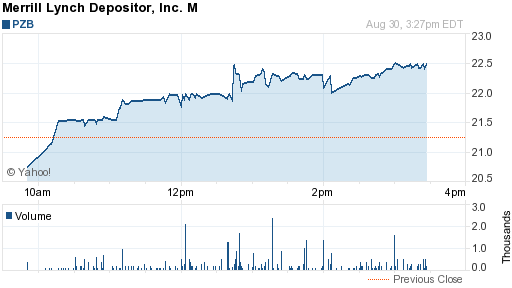Looking at the whole exchange-traded bond market, there is nothing ordinary going on – some up, some down, most of them less than a percentage point. It looks like a typical slow end of summer day – and indeed, this week no significant decisions will be made since a lot of decision-makers out there, including the President of the United States, are on holiday.
However, there is one significant blip on my radar, and considering up until today, I held onto them, was a trust preferred issue which is backed by March 2033 senior debt of Limited Brands, trading as NYSE: PZB. Already (at 12:30 Pacific, or 30 minutes to closing), 60,000 units have been traded, the highest volume day since July 8, 2009 (which was an unremarkable day).
Unlike back in July, today there was a clear and pronounced price increase, up 5.9% to 22.5 (90 cents to par value).
Why the price spike? I am not sure, but I suspect the trust preferred made it onto some newsletter or recommendation list.
Unlike the underlying debt which has a 6.95% coupon, PZB has a 6.7% coupon, which means it should trade below the bond price (which is currently 91 cents on TRACE). At 90 cents on the dollar, an investor in PZB would receive a 7.44% current yield, with a 0.47% implied capital gain if held and redeemed at maturity 22.5 years from now. An investor in the 6.95% senior bonds at 91 cents would receive a current yield of 7.64%, and an implied capital gain of 0.42% at maturity.
In my efforts to reduce duration and long-term corporate debt exposure, I have expunged my small position in PZB. It is a difficult decision, knowing that you are trading something with a decent and relatively secure yield for something that is giving you nearly nothing (cash interest), but keeping liquid is the name of the game – you will have ammunition to strike when the real opportunities start arising, whenever it may be. Having the discipline to holding onto substantial portions of cash is a crucial skill to survive in the markets.

